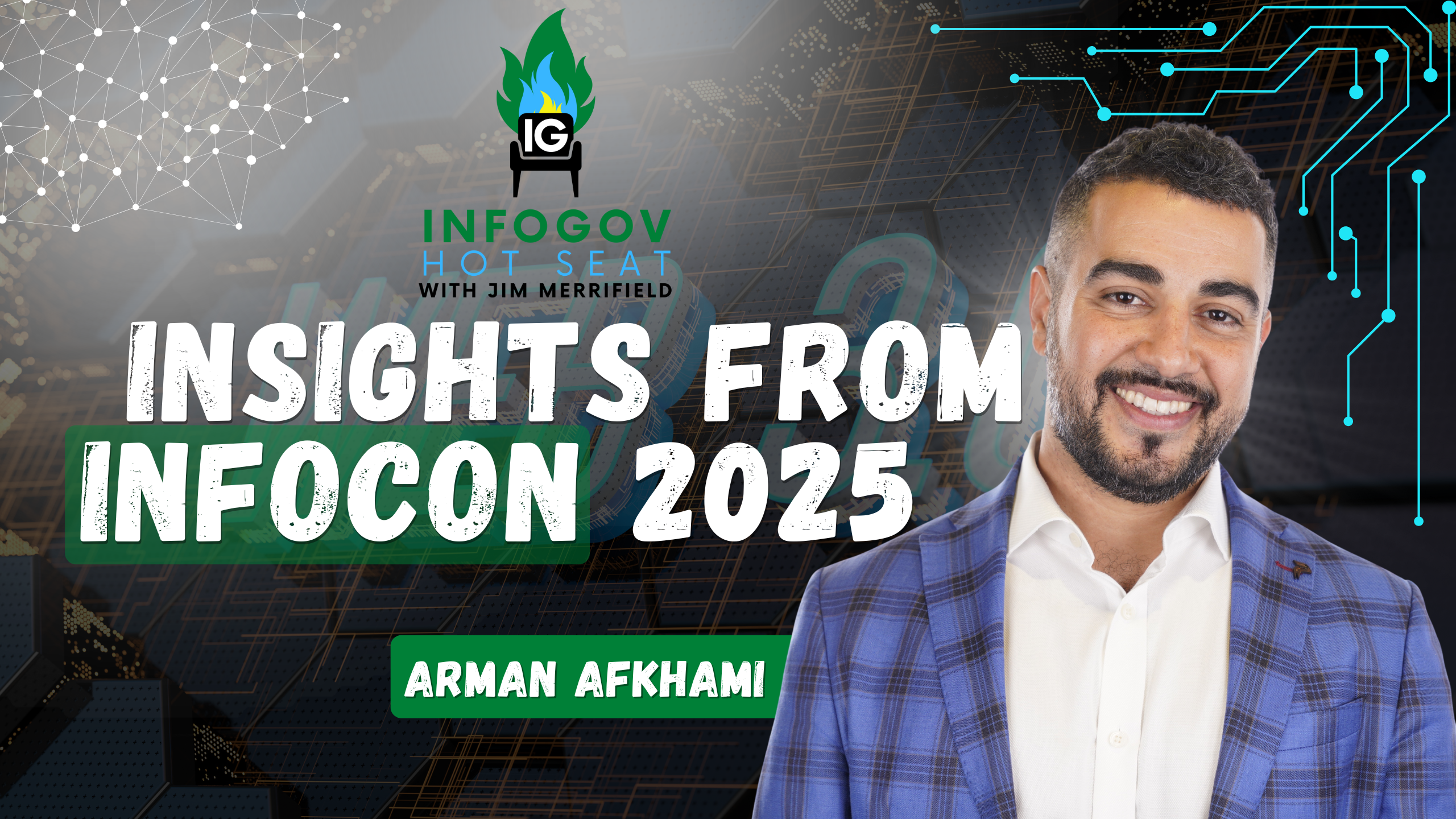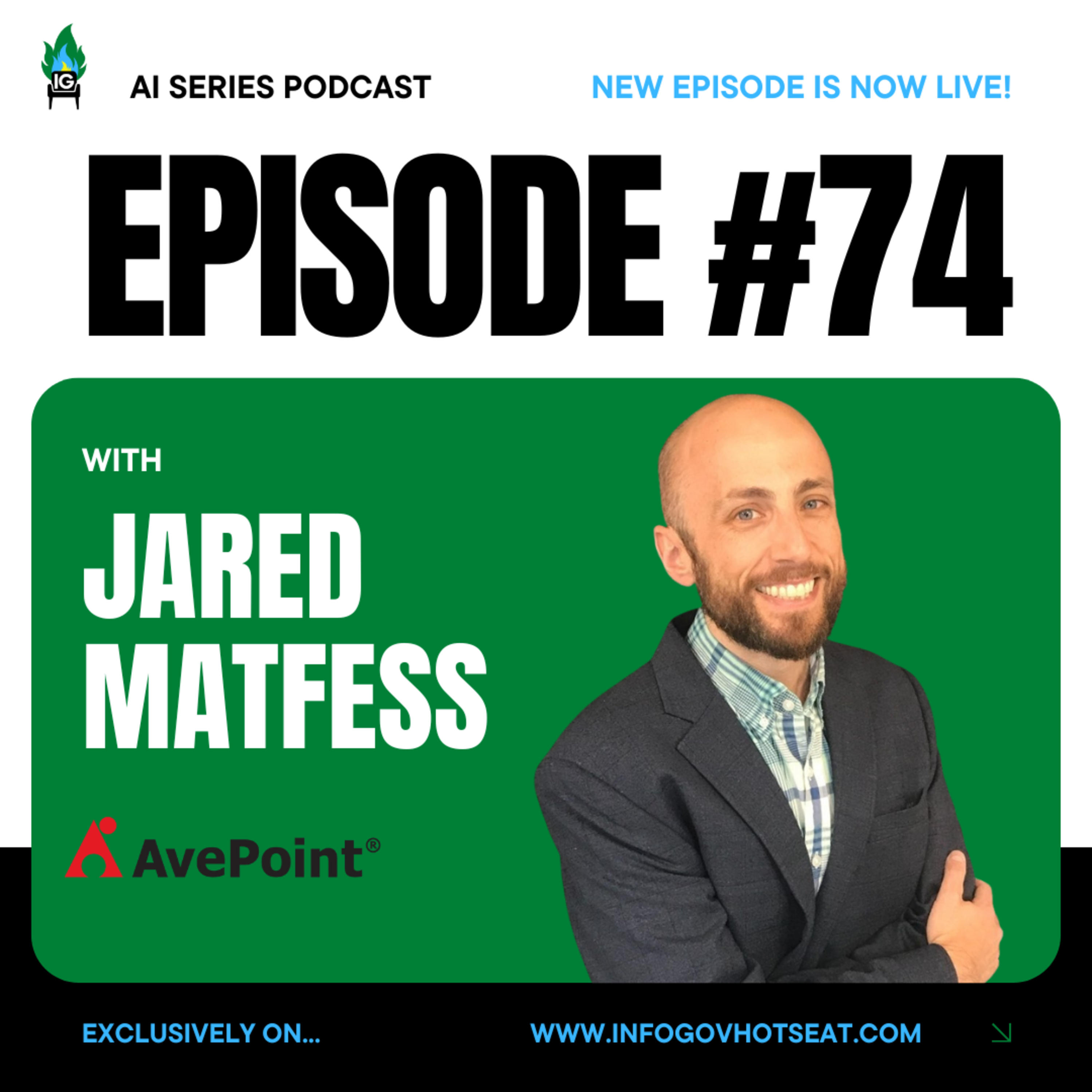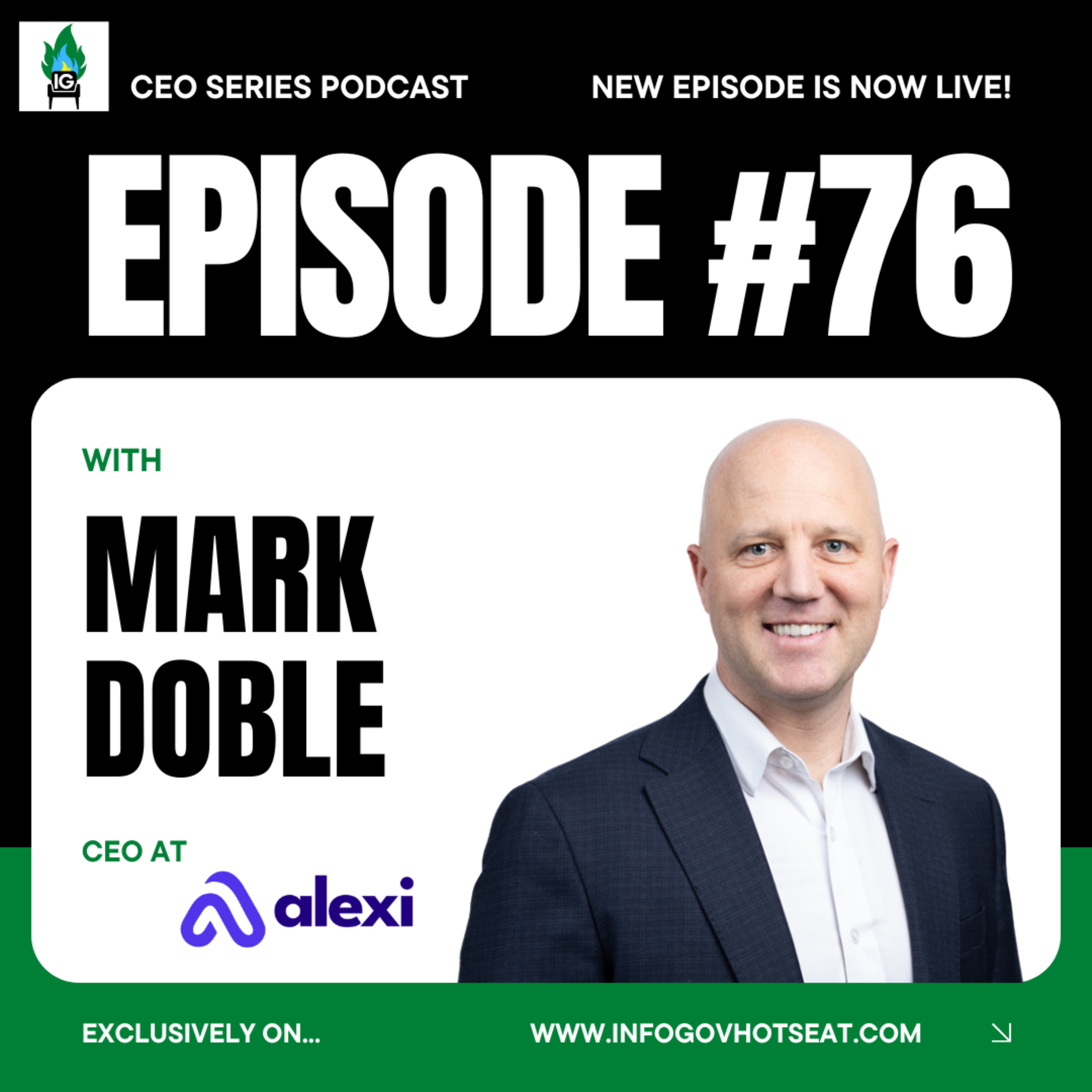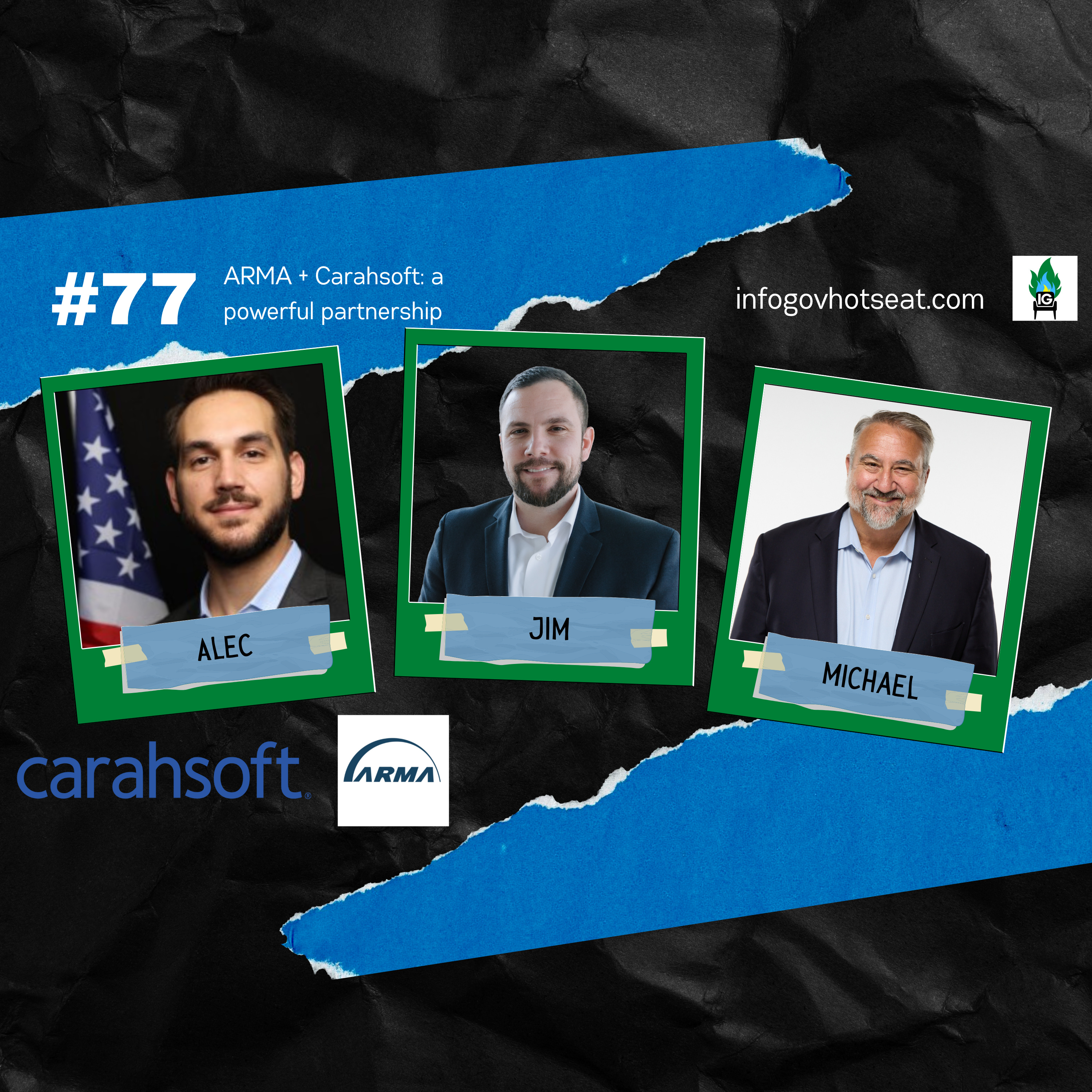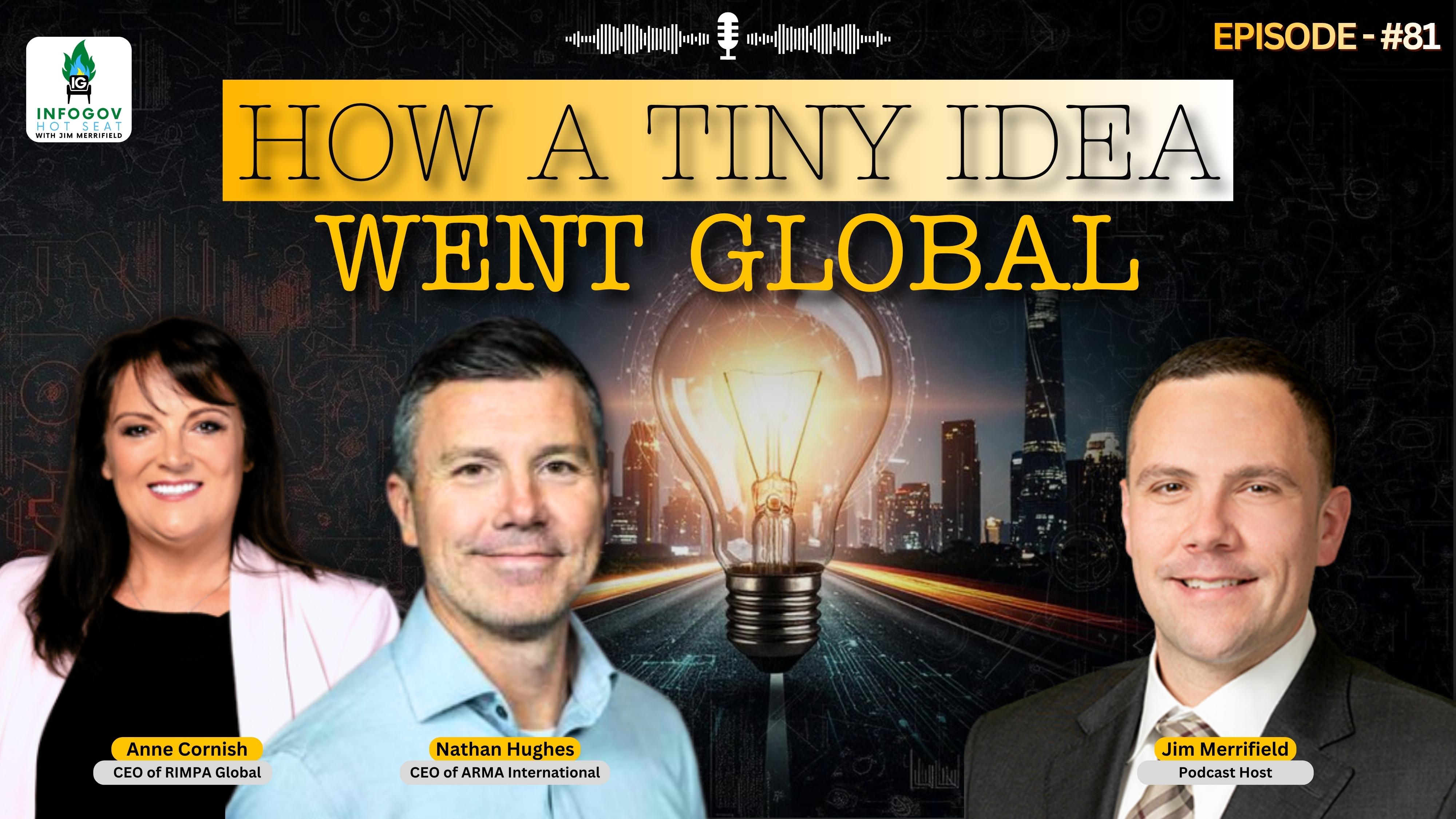UnBoxing CoPilot, A Microsoft MVP's Take
In this conversation, Jim Merrifield and Jared Matfess discuss the role of AI, particularly Microsoft's Copilot, in transforming productivity and business processes. Jared shares his background as a Microsoft MVP and solutions architect at AvePoint, emphasizing the importance of structuring unstructured data for effective AI implementation. They explore various use cases of AI in business, the significance of security and policy considerations, and best practices for organizations looking to adopt AI technologies. The discussion also highlights the potential pitfalls and future implications of AI in the workforce, advocating for a balanced approach to technology adoption.
Jim Merrifield (00:00.61)
Well, hello and welcome to the InfoGov Hot Seat. I'm your host Jim Merrifield and with me today is Jared Matfess at AvePoint. Welcome Jared.
Jared Matfess (00:08.813)
Hey Jim, thanks for having me. really looking forward to this conversation.
Jim Merrifield (00:12.142)
Yeah, it's great to have you on the hot seat. I neglected to say Jared is also a Microsoft MVP. So we're going to talk about like what the heck is a Microsoft MVP. I mean, I know what that is, but you know, our audience might not know what a Microsoft MVP is. I know it's a, it's a major achievement within the Microsoft space, but Jared, why don't you kick us off by providing a brief introduction to yourself and your current role.
Jared Matfess (00:36.965)
Yeah, awesome, Jim. Yeah, so again, Jared Matfess I work at AvePoint as a solutions architect. actually, so I'm based out of Hartford, Connecticut. I live in Berlin, so 17 minutes toward the door, who's counting. Grew up working in aerospace and defense, so like a lot of folks worked at Pratt & Whitney, ended up over at United Technologies. I became a customer of AvePoint. We were trying to solve a data security challenge and again, did a market scan to figure out who was in that space, ended up at AvePoint.
Implement the platform. And after that was a pretty big project. So you know what? need to go switch things up a bit. So I joined Slalom I was at 10 years at Slalom Consulting. So built up a technology practice focused on just solving really challenging business problems with technology. Towards the end of that, I found myself having a ton of conversations around AI readiness, AI maturity, getting ready for co-pilots. As you mentioned, I've also been in the Microsoft community for a long time.
I don't want say how old I am, definitely I've been around for a while. There's some wrinkles up here. Didn't used to have, and I was recognized by Microsoft for my contributions to the community was re-awarded, uh, MVP in the co-pilot category. And last July I joined AvePoint. So AvePoint, we are a data security company. And I think the punchline that makes it very simple to understand what we do is we help take your unstructured data and we apply structure to it. So if you are looking to adopt a co-pilot,
or maybe build custom agents, and they're going to rely on that unstructured user managed data, we help clean that up. Clean up permissions, clean up the contents, make it so you can safely and securely adopt AI technologies. So that's what we to do.
Jim Merrifield (02:16.526)
Great, you got a great background. You know, I love it. So you provide structure to our unstructured lives.
Jared Matfess (02:24.325)
Pretty much, yeah. I haven't been able to figure out how to apply that to my own personal life. Like I definitely have to pick the structure in my work life, but the unstruck on the personal life, I don't know. It's a little bit hard.
Jim Merrifield (02:34.156)
Yeah, tell me about it. So Jared, I know, you've worked as you mentioned, you've worked closely with Microsoft tools and technologies and you mentioned Copilot. How do you see Copilot transforming the way people use apps like, you know, Excel, PowerPoint, Word? Have you come across any surprising or creative use cases that you'd like to share?
Jared Matfess (02:57.989)
Yeah, I mean, it's interesting. it depends on the person, depends on their adaptability to new technology, what kind of, what patterns that they follow. You know, take a step back. What does this technology do? It allows you to create new content, summarize existing content. There's the ability for it to perform semantic searches. So you ask sort of, Hey, I shared this file with Jim two weeks ago. Can you go find that for me? And it kind of knows what that means semantically. Some of the interesting use cases that I've seen are actually going to sound weird.
more around learning. some of the, like taking the tools and using it to learn how to better use those tools. For example, how to write formulas in Excel or do create, you know, pivot tables or charts that maybe if you're not familiar with that technology, using it as a learning tool. And not only just in the individual applications themselves, but kind of an interesting way of working with AI is it's trained on lots of data.
So it's got quote unquote knowledge. We can definitely talk about more about knowledge later on. Um, but it's also good at prompting you if you use correctly. So as an example, one of the cooler use cases I've seen is I'm working on, you know, for like a more junior person, I'm working on pulling together a sales proposal and have it and asking, what are some things that you would need to know to make that specialized for this use case, for this scenario? And it provides you with that structured set of
questions where it's now prompting you, you've gone from prompting it to it prompting you, you then respond back and Azure, as you were providing it with more context, but to be able to predict what you're looking for, you're also learning along with it. You're like, Oh, a sales proposal includes this particular flow. I didn't quite know that. So it's an interesting kind of use case that not again, you could talk about how it creates slides or how it creates proposals, how it creates whatever, but like the learning part, I think it's kind of interesting and surprised me wasn't what I would have thought going in.
Jim Merrifield (04:57.154)
Yeah, it's super interesting. mean, some individuals have called, know, copilot or AI in general, like their second brain, you know, especially if you feed all that knowledge into it.
Jared Matfess (05:08.374)
I
Yeah. And I think the thing that makes it kind of cool too is I think, you know, there's a lot of, there's a lot of eyeballs on sort of the productivity impact. Everyone leads with productivity because you think that productivity is going to translate into ROI and savings, right? So if I'm more productive, that means I save time means whatever. I think the other lens that is being underplayed, but it's just as important, if not more, is the improvement to quality. Like I personally have observed
that the output of the artifacts that I create, whether they be presentations or emails or white papers, the quality is better because I'm able to partner with AI in the brainstorming around the topic, in the actual creation of it, and then the review after the fact. breaking down my own internal processes and using AI within that has leveled up my quality. I don't know if I do anything faster.
But I would say that the quality is better.
Jim Merrifield (06:11.79)
That's a smart approach for sure. So talking about daily workflows, there's a lot of, I think, use cases that people could focus on these days, whether you're a law firm, corporate environment, whatever. What do you see people focusing on as use cases and things within the next, say, I won't even go five years because I feel like five years is just way too long, maybe the next couple of years.
Jared Matfess (06:37.517)
Yeah, it's tough because the space is changing pretty rapidly. I would say that the people that are getting the most value out of us, I'm tweak your question a little bit and answer it though. I think the people that are getting the most value out of it are actually capitalizing on the fact that we've had, for many of us, have been disrupted by COVID. Like myself, I work 100 % remote. One of the areas that I'm lacking just from being no longer in an office,
Is that that person to bounce things off of like that sort of a, like chair turns to the right, ask a question to a person. We don't have that so much anymore. So I think the use cases and just the people that are able to kind of use AI as that person quote unquote, to bounce ideas off of, to sort of get the spark going. Like that's where you can really start to unlock value with just the co-pilot aspect of AI.
Now there's the co-pilot, which is sort of that assistant. And it's more about being engaged through prompts, texts that you send to it, while either you type it or you speak it. The next evolution though is the agents. And agents are going to be probably even more disruptive to the workforce than co-pilot. mean, agents are now targeted at business processes, which tend to have some better metrics around them.
The one I always talk about is contact center. You know on average about how long someone your contact center spends on a phone call. It's usually measured, it's usually quantified. If you can reduce that call time from seven minutes to six minutes, that's a minute per call, do the math on how many calls you get, you can start to extrapolate a value that's a true ROI. So agents is gonna be that next horizon of innovation and confusion. And it's just around the corner.
Jim Merrifield (08:34.958)
Yeah, I can't wait. That's a great point. I mean, I even notice, I don't know if it was a co-pilot functionality, but I noticed that there's always a suggestion with an outlook now to reduce my hour meetings to 45 minutes.
I don't know if it's because we have time just to have time to go to the bathroom or something, but, but I've actually been trying to do that. I mean, most meetings actually go an hour anyway, but maybe I'm saving 15 minutes because they don't go over right the hour. don't know.
Jared Matfess (08:51.621)
That's a good thing.
Jared Matfess (09:06.799)
Well, the nice thing, hopefully you're able to tap into Copilot to do sort of the capture of the meeting minutes, be to distribute the next steps. Like that definitely is a, that's honestly like the easiest use case where I'm seeing a lot of customers get the most value is just for meetings because for knowledge workers, most of your time is spent unfortunately in meetings. So.
Jim Merrifield (09:25.9)
Yeah, that's powerful. mean, even a podcast like this, right? I mean, everything we're saying is being transcribed right now, right? It's being captured. And honestly, I've been doing this for about, I don't know, almost three years. And the transcription technology with this platform, you know, using Riverside, it's pretty amazing. I mean, it's really close to the exact text that we're actually saying.
Jared Matfess (09:53.636)
Yeah, well, it's good for me to somewhere that mumbles quite a bit when I talk as if my mother has told me growing up, I don't always enunciate. even it's funny to talk about edge use cases like doing training videos or doing interviews. Like think about how you can repurpose this medium using AI and do it faster. You could have it analyze the transcript and point out like what are the three most impactful points that someone made during that.
Jim Merrifield (09:58.478)
you
Jared Matfess (10:21.497)
You could even figure out ways to segment out like from a timestamp perspective. Hey, like let's pull out a couple of 10 second, you know, micro clips and then post that on social media. you know, those interesting edge use cases around data that you have and repurposing data for other purposes is all amazing. That makes this stuff kind of exciting.
Jim Merrifield (10:39.726)
Absolutely. mean, you used to have to use so many different, you had to do that manually, right? Start doing cuts and everything else. Now everybody can, you know, it's not that hard to do podcasts and create content anymore.
Jared Matfess (10:44.409)
Yeah.
Jared Matfess (10:50.6)
No, that's true. know you're trying to, AI might be putting you out of a job at some point. Fair.
Jim Merrifield (10:54.764)
Yeah, you never know. You never know. Good thing this is a hobby. But yeah, so so listen, Jared, I know there's plenty of organizations that have deployed copilot, but there's also plenty of organizations as well that are kind of hesitant. Maybe from a security privacy perspective, what advice would you have for an organization that maybe deployed copilot already, but or actually someone who's
thinking about deploying. Maybe let's focus on the company that actually is thinking about deploying, right? Because that's probably the best stage.
Jared Matfess (11:33.397)
Yeah, and that's when I'm working with a customer right now. in that they want to experiment with about 50 copilot licenses. They want to go get that in the hands. And it's funny, I always say like, you don't pilot, copilot, you do a test flight because otherwise it's too confusing. Copilot pilot just sounds weird. But they want to understand, is this something that makes sense to invest in? And who might be the right people to get these licenses?
You you start off typically with like personas and you want to really do a double click down because underneath persona, people are different and people have different degrees of adaptability. My advice is start off first with policy. Ignore, ignore tech for a moment. Let's just talk about that. You've you're concerned around risk. You're worried about the AI exposing data that you have access to that perhaps you shouldn't or disclosing things. You solve that through policy, just like any other thing within your organization.
AI acceptable use policy, have people sign that prior to actually getting their license, go through some education around what are some of the gotchas with this. I think the number one gotcha is it's not always right. mean, copilot is way more confident than I am. It's got way more confidence than anything I always say. was feeling I'm always hedging my bets on how I deliver messages, but copilot is like super confident. Like I wish I had that, I wish I bottle that up.
So you have to remind people that it's trained on language. wants to convince you that's part of its reward mechanism. So, you know, be a little bit cautious around that. a little bit, kind of tap into the East Co vibe of like, I don't know if I really trust that. I want to go verify that before I go put that out there because again, this technology doesn't really know things. I think that's a misnomer. I think people think, GPT knows everything.
It really doesn't quote unquote, know, it doesn't really quote unquote think. And there's some debate around, does it think or not? but it's really these large language models are predicting like that's what they do. They predict, they break everything down into ones and zeros. And it looks for patterns. It tries to recommend the pattern based on what it thinks you're looking for. So remember it will guess incorrectly, from time to time and you got to call it out and you got to be aware of that. so yeah, I think.
Jared Matfess (13:52.722)
As much as there's the, you know, evaluate and do an assessment of your landscape, really start with just policy, policy procedures, education first, and then worry about doing the scan of your environment next to try to untangle some of those permissions.
Jim Merrifield (14:08.492)
Makes perfect sense, right? People usually focus on, or organizations rather, focus on the security, the permissions, and when you say policy, I mean, you could put a policy in place. I love how you mentioned have people sign it, and then actually, hopefully have the technology that you can actually enforce the policy, right? And know how to enforce the policy on the Microsoft stack, right? You might have to call a partner for that, but.
but now all great advice. So Jared, I know we talked about a lot here. I know you're posting all the time on LinkedIn, different resources and things, definitely positioning yourself as a thought leader in this space. Are there any resources that you would point people to to maybe learn more about co-pilot, whether you're a law firm or corporate legal, anything specific?
Jared Matfess (15:03.031)
It's a law firm, corporate legal. That was a little bit tough. mean, honestly, I don't think the content that's freely available is all the way out there. But with that being said, there are a lot of interesting ways that you can identify use cases, whether you're corporate legal or manufacturing or financial services. And it's going to come down to involving the people, the people that are closest to the work. As much as all law firms might have similarities,
how you operate as a business is going to be very different. So your procedures, your roles, your tone, your brand, like all of those things. What I have found is that when organizations try to not go and replicate what else is out there, but actually do that internal look at just sort of their own, again, processes, arrangements, work structure, all that fun stuff, and do structured activities, that's where you start to net out the best use cases. And I think it's important to note that
Copilot and even AI isn't the solve for everything. I know it's a pretty big sledgehammer right now and there's a lot of money to be made in in making it be the solution, but it's not always the right solution. when you think about and just like as a couple examples, right? You know a well structured process. AI might not be the true solution for that where it's like it against very well defined like, you know, there's not a lot of ambiguity.
There are other technologies. There's RPA, there's process automation with like power automate. But when you start to layer in the need for reasoning, so, and I know I just said that like Copa doesn't think and large language models don't think, but they do kind of reason over content, tries to unpack it, to make, to find similarities. That's when you can start to maybe incorporate that into your workflow. know, things like where you want to personalize a message to an individual.
based on circumstances, you can allow reasoning to send that out. real one, realish one maybe for you all. As I mentioned before, like lawyers speak a different language than the rest of us normal people. Like we, they use terms that I just don't understand. I occasionally know the word, but I don't know the word in the context of how it's being presented to me. But you could leverage AI to simplify that for us non-legal folks to understand.
Jared Matfess (17:23.653)
when you're trying to communicate risk or exposure or, you know, that doing so in more of a fifth to sixth grade reading comprehension level is probably going to hit a larger population than the highly educated lawyer that again is speaking in. Not even absolutes, but just interesting language. And so getting back to just sort of the, do you get those use cases? It's an eye of fact that running structured activities with a cross representation of people in your firm.
is the best way to unlock value and unlock use cases. Because what you do is you get people out of the element, get them out from away from their desk, have them in a conference room, and have them do something where a brainstorming exercise. Start with a little bit of education. This is co-pilot. This is how GenAI works. Here's some generic use cases that we've seen. And then split them up into groups and have them brainstorm based on the work that you do, your day to day.
What are some tasks that you don't enjoy doing? What are areas that you find yourself spending, you know, sort of non-creative time and have them start to, to, to hypothesize would AI help them in some ways and how, and put that on that sticky note. Give them a couple of minutes to go brainstorm as a team. Then you say, time's up. Guess what we're going to do this as an activity. Everyone's going to rotate. Everyone's going to go look at what they're the previous group did and look at the list. Think again about sort of you, the work that you do.
and add to that list. And maybe do that one more time. Give them like four minutes and let them kind of brainstorm. And then have them go back to that original list of use cases and have them share with the class the top two, ones that they think would be the most impactful. You can then look at those use cases, look at the technology and figure out, does this align to copilot? Does this align to an agent use case? Does this align to business process automation?
It's a helpful way to get people excited about the technology, maybe lean in a little bit to do a little bit more experimentation. And I've seen firms use that approach, or organizations use that approach to just get some ideas and have it be in the language of your company and not the generic like Microsoft Contoso org, which doesn't exist. Maybe I don't think it does.
Jim Merrifield (19:37.698)
Yeah, hey, seems like a great path. Path forward, who knows, maybe I'll be calling you, you know, to facilitate that.
Jared Matfess (19:44.493)
As long as there's like snacks, if you have snacks, like people love snacks to you. was the one thing I forgot to mention. You gotta have snacks. Otherwise they don't fit.
Jim Merrifield (19:48.18)
yeah.
Yeah, you gotta have food. You have to have food. People come for food.
Yeah, yeah, for sure. Or that or free stuff, whatever. Give them a t-shirt or something.
Jared Matfess (20:03.941)
That's true. Free swag. I know the amount of things you can get people to do for a free t-shirt is incredible.
Jim Merrifield (20:09.358)
telling you or like a stress ball or something or a pair of socks, you know, I don't know. anyway, Jared, I know we've talked about a lot here. Is there anything that you'd love to share with the audience that you didn't get to share before we let you go?
Jared Matfess (20:11.335)
Hahaha
Jared Matfess (20:23.437)
I think it's the one caution. want to share one caution. think there's a lot of excitement around AI. And I think that the marketing and the hype is a little bit further ahead than the technology in some ways. So while there's this gold rush to go invest in the technology, I think you have to temper that with expectations of what it can actually do today. And also what does it mean to target certain segments? And so why I bring that up is I've had a lot of customers
talk about like maybe trying to leverage AI for entry level roles. So maybe we don't hire people fresh out of college. We go and automate that process with AI. And as we were talking about knowledge a little bit earlier, it's important to note that there's been a lot of studies. In fact, there was one that I read. It's almost like seven years old. I think at this point, it was put out by Uconn and it was talked about how people, how adults learn. And it's like a 70, 20, 10 rule. And I don't remember the exact breakdown, but
The genesis is most adults learn through doing, through experiences. So if you try to target sort of entry level roles and replace that with AI, you're now impacting that pipeline of new talent to your organization. And how do you bring in new talent that's experienced if they aren't able to get experience somewhere? So while there might be some savings on the front end,
there's losses on the back end. And you have to really think like, what is your true talent strategy? And I bring that up because I look at a lot of organizations are not good at bringing in experienced employees. They struggle with that, right? And how do you trust this person that hasn't been here for 10 years, but they've got 10 years experience elsewhere? Like, what does that house at the trans? But you tend to trust people that you brought in out of college and they have to stay with your firm for 10 years. If you don't have that pipeline, where are they coming from? And how do you operate as a business? So
I just want to put that out there as well. There's probably a lot of focus around how do we tap into this to reduce costs. I do think there's an opportunity to improve quality, which should hopefully swing the pendulum into your profitability as well without just cutting heads. Again, just want to make sure that.
Jim Merrifield (22:35.404)
Yeah, that's a great point. I think it's a great point. mean, you you're crushing that pipeline. I don't know, maybe there's some focus or maybe there's lower expectations with people coming out of college. I don't know. Like I think 20 years ago when I'm 2004 or something, 21, I'm dating myself. But like when I came out, you know, I don't know, was there low expectations for me at the firm? I don't
Jared Matfess (22:58.981)
Yeah, I I think there were, right? I mean, I think it's actually funny too. You know, I started out as a co-op working at Pratt, which is like one level above intern, not quite, but just a slight sort of edge on the intern. And there's been that analogy of treat AI as an eager intern. It wants to please you, but it's going to get things wrong from time to time. But those interns are important as part of the workforce. They contribute in lots of different ways. You know, I just remember and...
part of the experience too, one of the food for thought too, and in this weird hybrid world of people being remote. Don't forget those younger employees need coaching and mentoring, and AI in some ways can actually contribute to the isolation of those individuals. So how do you layer in-person human experiences to ensure that they are learning and growing and maturing so that you get the value out of them as they stay with your organization?
Jim Merrifield (23:55.758)
That's an excellent point and I'm sure we'll have a part two to this conversation. know, yeah, no, thank you so much, Jared, for spending some time here on the Hot Seat, answering some of these questions around Copilot and Microsoft Stack and even AI in general. If you'd like to be a guest on, for our audience, you'd to be a guest on InfoGov Hot Seat, all you gotta do is submit your information through our website, infogovhotseat.com. And thank you so much. Enjoy the rest of your day.
Jared Matfess (24:00.588)
Happy Thu-
Jared Matfess (24:24.965)
from YouTube. Thanks Jim.
Jim Merrifield (24:27.17)
So I just hit stop. tell you this is the software is like.

Jared Matfess
Solutions Architect
Jared Matfess is an AI Architect at AvePoint, bringing over ten years of industry experience and a decade in consulting to help organizations harness the transformative power of artificial intelligence. A Microsoft MVP and published author, Jared specializes in bridging cutting-edge technology with real-world business solutions. Leveraging his expertise in the Microsoft ecosystem, he designs and delivers strategies that drive digital transformation, streamline processes, and unlock new opportunities. Jared earned his Bachelor’s degree in Computer Science from the University of Hartford, an MBA from the University of Massachusetts at Amherst, and a Master of Science in Computer Information Systems from Boston University. He frequently speaks at industry events, inspiring teams to discover the full potential of AI.









